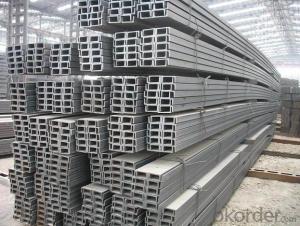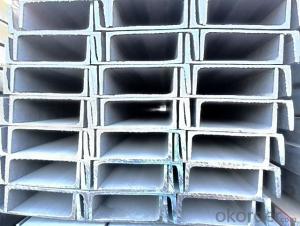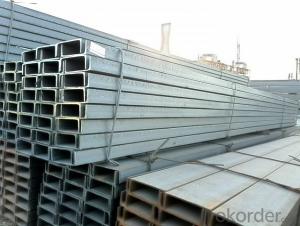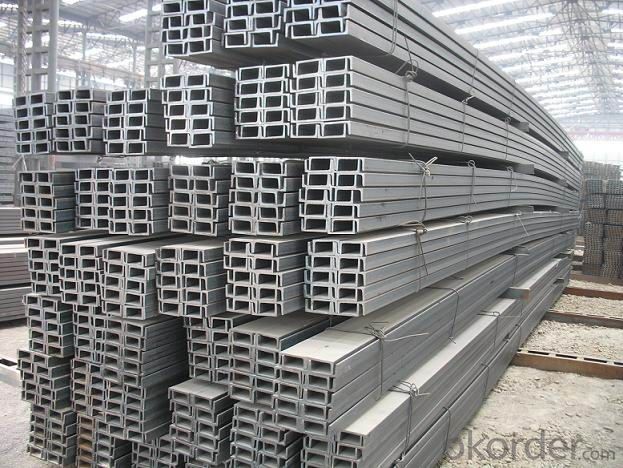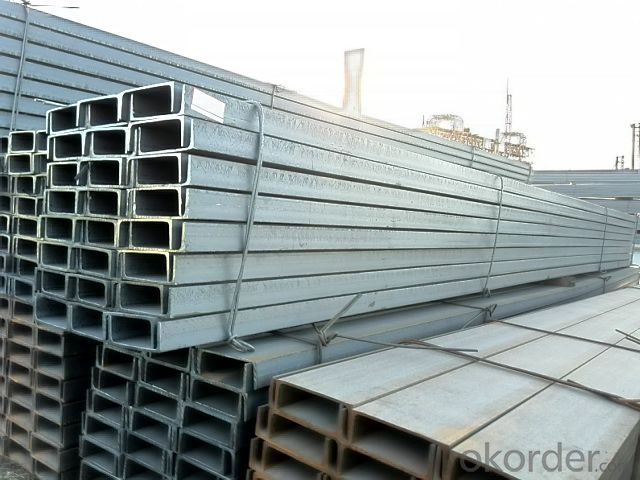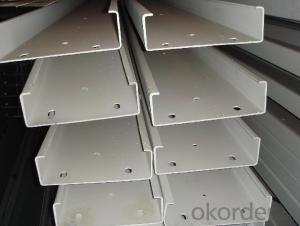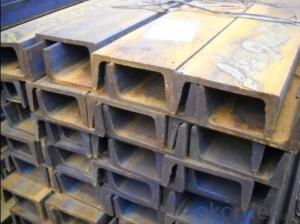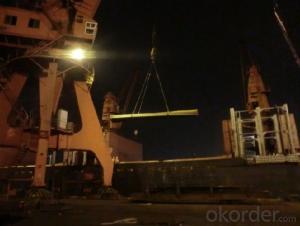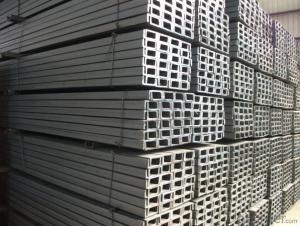U-Channels with Best Price Source from China Market
- Loading Port:
- Tianjin
- Payment Terms:
- TT OR LC
- Min Order Qty:
- 25 m.t
- Supply Capability:
- 10000 m.t/month
OKorder Service Pledge
OKorder Financial Service
You Might Also Like
Specification
Okorder.com is a professional materials & equipment supplier & manufacturer, offers integrated one-stop services including real-time quoting and online cargo tracking. We are funded by CNBM Group, a Fortune 500 enterprise and the largest materials & equipment firm in China.
Product Applications:
The MS Channel can be applied to construction of warehouses, workshops, sport stadiums and car parks etc.The hot rolled channel steel belongs to carbon structural steel which is applied to in the field of construction and machinery.In details, the hot rolled channel steel is usually used for arch-itechtural structure, and they could be welded in order to support or hang a vari-ety of facilities. They are also usually used in combination with I beam. Generally,the hot rolled channel steel we supply must possess perfect welding property, riveting property and mechanical property and so on.
Product Advantages:
OKorder's Steel U-Channels are durable, strong, and resist corrosion.
Main Product Features:
· Premium quality
· Prompt delivery & seaworthy packing (30 days after receiving deposit)
· Corrosion resistance
· Can be recycled and reused
· Mill test certification
· Professional Service
· Competitive pricing
Product Specifications:
1.We supply high quality MS Channel at reasonable price, including Chinese standard, Japanese standard and so on.
Standard | GB/JIS |
Material Grade | Q235,SS400 |
Technique: | Hot Rolled |
Sizes as per chinese standard: | 50*37*4.5mm - 300*89*11.5mm |
Sizes as per japanese standard: | 50*25*3mm – 200*80*7.5mm |
Length: | 6meter, 9meter, 12meter |
Note: 1.we are also competent to provide our customers other MS Channel based on other sizes according to customer’s requirements.
2. The length of our ms channel could be cut into other meters as per customer’s requirements. For example, the channel in 6meters could be cut into 5.8meters in order to be fit in the 20ft container.
2. The detailed sections of MS Channel as per GB standard.are shown in the table-1:
GB U CHANNEL | Standard | Sectional | Dimension |
| Mass: |
(mm) | (mm) | (mm) | (mm) | ||
50X37 | 50 | 37 | 4.50 | 7.0 | 5.438 |
63X40 | 63 | 40 | 4.80 | 7.5 | 6.634 |
80x43 | 80 | 43 | 5.00 | 8.0 | 8.045 |
100x48 | 100 | 48 | 5.30 | 8.5 | 10.007 |
120x53 | 120 | 53 | 5.50 | 9.0 | 12.059 |
140x58 | 140 | 58 | 6.00 | 9.5 | 14.535 |
140x60 | 140 | 60 | 8.00 | 9.5 | 16.733 |
160x63 | 160 | 63 | 6.50 | 10.0 | 17.240 |
160x65 | 160 | 65 | 8.50 | 10.0 | 19.752 |
180x68 | 180 | 68 | 7.00 | 10.5 | 20.174 |
180x70 | 180 | 70 | 9.00 | 10.5 | 23.000 |
200x73 | 200 | 73 | 7.00 | 11.0 | 22.637 |
200x75 | 200 | 75 | 9.00 | 11.0 | 25.777 |
220x77 | 220 | 77 | 7.00 | 11.5 | 24.999 |
220x79 | 220 | 79 | 9.00 | 11.5 | 28.453 |
250x78 | 250 | 78 | 7.00 | 12.0 | 27.410 |
250x80 | 250 | 80 | 9.00 | 12.0 | 31.335 |
250x82 | 250 | 82 | 11.00 | 12.0 | 35.260 |
280x82 | 280 | 82 | 7.50 | 12.5 | 31.427 |
280x84 | 280 | 84 | 9.50 | 12.5 | 35.823 |
280x86 | 280 | 86 | 11.50 | 12.5 | 40.219 |
300x85 | 300 | 85 | 7.50 | 13.5 | 34.463 |
300x87 | 300 | 87 | 9.50 | 13.5 | 39.173 |
300x89 | 300 | 89 | 11.50 | 13.5 | 43.883 |
Table-1
FAQ:
Q1: Why buy Materials & Equipment from OKorder.com?
A1: All products are carefully selected from China's most reliable manufacturing enterprises. Through its ISO certifications, OKorder.com adheres to the highest standards and a commitment to supply chain safety and customer satisfaction. We can guarantee the quality!
Q2: The products are invoicing on theoretical weight or on actual weight?
A2: We can do it in both manners, it’s according to buyer's requirement.
Q3: Can you offer the third part inspection certificates ?
A3: We are able to present our customers relevant SGS test report for mechanical property of MS Channel as customer’s request.
Images:
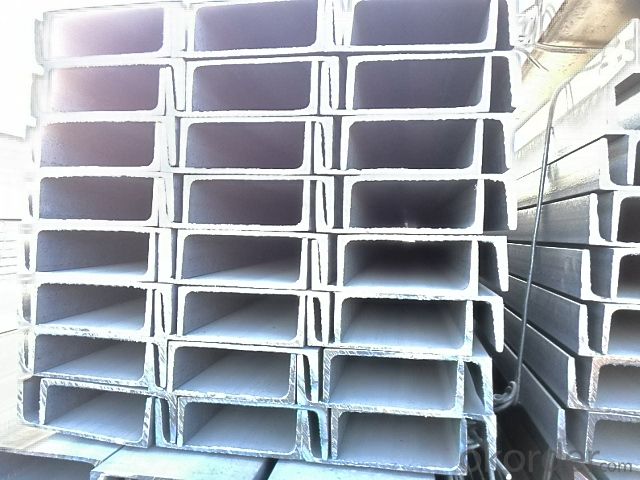

- Q: Can steel channels be used in outdoor environments?
- Yes, steel channels can be used in outdoor environments. Steel is a durable and strong material that is capable of withstanding various weather conditions and environmental factors. It has excellent resistance to rust and corrosion when properly coated or galvanized, making it suitable for outdoor applications. Steel channels can be used in outdoor construction projects such as bridges, fences, railings, and support structures. However, it is important to ensure that the steel channels are properly protected and maintained to prevent any potential damage or degradation over time.
- Q: What are the tolerance limits for steel channels?
- The tolerance limits for steel channels depend on various factors such as the manufacturing process, the specific type of steel channel, and the industry standards. Generally, tolerance limits refer to the acceptable deviation from the specified dimensions or properties of the steel channels. In terms of dimensions, tolerance limits may include tolerances for width, height, and thickness of the channel. These limits ensure that the channels meet the required specifications and can be used effectively in various applications. For example, the tolerance limits for the width of a steel channel might be ±0.005 inches, meaning the actual width of the channel can vary within this range. Additionally, tolerance limits may also apply to other properties of steel channels such as straightness, squareness, and surface finish. Straightness tolerance ensures that the channel is not bent or warped beyond acceptable limits. Squareness tolerance ensures that the corners of the channel are at right angles to each other. Surface finish tolerance refers to the smoothness and quality of the channel's surface. It is important to note that different industries and applications may have specific tolerance requirements. For instance, channels used in structural engineering and construction may have different tolerance limits compared to channels used in manufacturing or fabrication processes. To determine the exact tolerance limits for steel channels, it is necessary to refer to industry standards and specifications such as those provided by organizations like the American Society for Testing and Materials (ASTM) or the International Organization for Standardization (ISO). These standards outline the acceptable tolerance limits for various dimensions and properties of steel channels, ensuring consistency and quality in their production and use.
- Q: What is the standard length of steel channels?
- The standard length of steel channels can vary depending on the manufacturer and specific requirements but it is commonly available in lengths of 20 feet (6.1 meters) or 40 feet (12.2 meters).
- Q: How do steel channels hold up against extreme temperatures?
- Steel channels are known for their exceptional strength and durability, making them highly capable of withstanding extreme temperatures. The properties of steel, such as its high melting point and thermal conductivity, allow steel channels to maintain their structural integrity even when exposed to extreme heat or cold. When subjected to high temperatures, steel channels expand at a slower rate compared to other materials, which helps to minimize the risk of deformation or failure. This resistance to thermal expansion is due to the low coefficient of linear expansion of steel. This property ensures that steel channels maintain their shape and structural stability even under extreme temperature fluctuations. Furthermore, steel channels possess excellent fire resistance. Steel has a high melting point, typically ranging from 1370°C to 1530°C (2500°F to 2800°F), which means it can withstand intense heat without losing its structural integrity. This makes steel channels a reliable choice in applications where fire protection is crucial, such as in buildings, bridges, or industrial structures. On the other hand, steel also exhibits good performance in cold temperatures. Unlike some materials that become brittle or weak when exposed to low temperatures, steel retains its strength and ductility. This makes steel channels suitable for use in environments with extremely cold temperatures, such as in arctic regions or cryogenic facilities. In conclusion, steel channels are highly resilient to extreme temperatures due to their low coefficient of linear expansion, high melting point, and overall durability. Whether exposed to intense heat or cold, steel channels maintain their structural integrity and provide long-lasting performance, making them a reliable choice in various applications.
- Q: How do you mark the types of steel such as channel, I-beam and so on in the document?
- Like the board, tube, and so on, right click on the Greek character mother with the keypad of the input method, and then choose.The thickness of the plate said.Phi means the diameter of the tube.H section steel, it is direct capital letters, H said in front of the good.A worker is a worker..Angle is digital symbols with small keyboard input method to select right angle of mathematical symbols.The slot is the keypad of the input method. Right click on the punctuation mark.By analogy.....
- Q: How do steel channels contribute to the overall cost savings of a structure?
- Steel channels contribute to the overall cost savings of a structure in several ways. Firstly, steel channels are lightweight and easy to handle, which reduces transportation costs. Compared to other materials like concrete or wood, steel channels are more efficient to transport due to their high strength-to-weight ratio. This means that fewer trucks or containers are needed to transport the same amount of steel channels, resulting in lower transportation costs. Another cost-saving aspect of steel channels is their durability and long lifespan. Steel is highly resistant to corrosion, weathering, and pests, which means that structures built with steel channels require minimal maintenance and repairs over time. This reduces the need for costly maintenance work and extends the lifespan of the structure, resulting in long-term cost savings. Additionally, steel channels offer flexibility in design and construction. They can be easily customized and fabricated into various shapes and sizes, allowing for efficient use of materials and minimizing waste. This flexibility also contributes to faster construction times, reducing labor costs and overall project duration. Furthermore, steel channels are highly recyclable. At the end of a structure's life cycle, steel channels can be easily recycled and reused in other projects. This not only reduces the environmental impact but also provides cost savings by avoiding the need for new raw materials. Lastly, steel channels offer excellent structural performance, providing high strength and stability to the overall structure. This allows for the use of smaller section sizes, reducing material costs without compromising structural integrity. In summary, the use of steel channels in a structure contributes to cost savings through reduced transportation costs, low maintenance requirements, efficient use of materials, faster construction times, recyclability, and optimized structural performance. These factors make steel channels a cost-effective choice for construction projects.
- Q: What is the concept of nonstandard channel steel compared with the national standard channel steel? Is there any difference in size between the national standard channel steel and the material?
- Non-standard channel steel, with channel steel waist height, leg width, waist thickness and per meter weight as the standard, non-standard channel steel, mainly in order to not affect the safety quality of the premise of cost saving, in high, wide and thick discount. For example, 12# channel weight per meter 6 meters for 12.059kg, 72.354kg, and 12# 6 if a channel is 48kg, then we call it under 33.3% (1-48/72.354). In our country, most of the steel market has sales of non-standard profiles, this is called "cut foot".
- Q: The two floor is made of channel steel barrier, but also want to do a toilet, just sitting and washbasin, so that the bathroom floor tiles can be it? What special treatment do you need? Ask designer friends for advice
- The wall board is very troublesome, first is waterproof and load-bearing problems (wall tiles), wood best brush a layer of insulation waterproof soft waterproof glue, then construction
- Q: Use two long five meters of 10# channel steel load-bearing frame, the maximum load is?
- Set a span of 4.8m, two 10#Q235 channel parallel, as the beam, the required load is concentrated load, the role in the middle of channel.
- Q: How do steel channels contribute to the overall ease of maintenance for a structure?
- Steel channels play a crucial role in simplifying the maintenance of a structure in various ways. Firstly, they offer structural support and reinforcement, ensuring the stability and longevity of the building. This means that repairs and maintenance are less frequent, as the structure can withstand external forces like wind, earthquakes, and heavy loads without significant damage or deformation. Moreover, steel channels are highly durable and resistant to corrosion, rust, and decay. Unlike materials such as wood or concrete, they do not rot, warp, or deteriorate over time. Consequently, regular inspections, repairs, or replacements due to structural degradation are unnecessary. Furthermore, steel channels are easy to fabricate and install, promoting efficient construction and maintenance processes. Their versatility allows engineers and architects to design and modify structures with ease, facilitating necessary repairs or renovations. As a result, maintenance activities cause minimal downtime and disruption. Additionally, steel channels possess a high strength-to-weight ratio, making them lightweight yet incredibly robust. This quality simplifies the transportation and handling of steel channels during maintenance projects. It also minimizes the need for extensive structural modifications, as steel channels can often be added or replaced without compromising the overall integrity of the structure. Lastly, steel channels can provide fire resistance, enhancing safety and ease of maintenance. In the event of a fire, they can help contain the spread of flames, minimize damage, and aid in the restoration process. This reduces the complexity and cost of maintenance in fire-related incidents. In conclusion, steel channels contribute significantly to the overall ease of maintenance for a structure through their structural support, durability, corrosion resistance, ease of fabrication and installation, lightweight design, and fire resistance. These attributes result in reduced maintenance requirements, increased structural integrity, and improved cost-effectiveness throughout the lifespan of a building.
Send your message to us
U-Channels with Best Price Source from China Market
- Loading Port:
- Tianjin
- Payment Terms:
- TT OR LC
- Min Order Qty:
- 25 m.t
- Supply Capability:
- 10000 m.t/month
OKorder Service Pledge
OKorder Financial Service
Similar products
Hot products
Hot Searches
Related keywords
